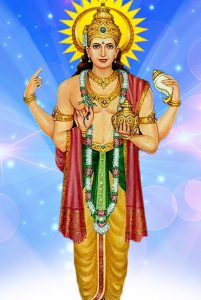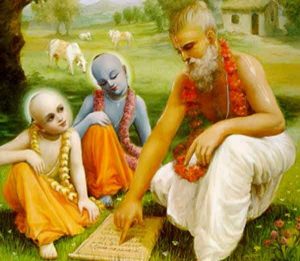About Ayurveda
हिताहितं सुखं दुःखमायुस्तस्य हिताहितम् ।।
मानं च तच्च यत्रोक्तमायुर्वेदः स उच्यते । च.सू. 1/14
आयुरस्मिन् विद्यते, अनेन वाऽऽयुर्विदन्ति” इत्यायुर्वेदः ।। सु.सू. 1/15
Ayurveda, the science of life and longevity has a history as long as a human civilization and even beyond. Ayurveda is made up of two Sanskrit words: Ayu which means life and Veda which means the knowledge of.
To know about life is Ayurveda. “Ayu” or life is comprised of four essential parts –
The combination of mind, body, senses and the soul.
शरीरेन्द्रियसत्वात्मसंयोगो धारि जीवितम् ।
नित्यगश्चानुबन्धश्च पर्यायैरायुरूच्यते ।। च.सू.1/42
Ayurveda is believed to be eternal. Ayurveda is considered as the medical knowledge of heaven descended to earth.
Ayurveda avataran or the procurement of the knowledge of Ayurveda has been described with interesting tales through Indian mythology.
There are two important legends which are mainly discussed.
The first one follows the Daivya Parampara from the Aatreya Sampradaya (or the School of physicians) and the second one is the mythological tale from puranas which follows the Dhanvantari Sampradaya (or the School of surgeons).
According to the Daivya parampara, Ayurveda descended to earth from Lord Brahma. Lord Brahma is known in Indian mythology as the creator of universe. Lord Brahma snatched knowledge from all direction and compiled his own Brahmasutra. The Brahmasutras were passed on to Daksha Prajapati in 100,000 verses. Daksha Prajapati passed on the knowledge of Ayurveda to the twin brothers Ashwini kumar, Lord Indra inherited Ayurveda from Ashwins, then from Indra it was passed on to the Sages headed by Bharadwaj and they passed on to their disciples.
According to Dhanvantari Sampradaya ayurveda was procured in the Samundramanthan (Churning of Ocean) with Lord Dhanvantari . Lord Dhanvantari emerged with Nectar in one hand and Ayurveda in the other. This is why Lord Dhanvantari is worshiped as the God of Ayurveda.
Its written history takes definite shape with the codification of hundreds of slokas of Ayur-Vedic wisdom into ‘Samhitas‘. Its highly integrated approach is evident from the way Ayurvedic treatment was divided into eight segments such as
1. Kaya Chikitsa (General medicine)
2. BalaChikitsa (Pediatrics)
3. Graha Chikitsa (Psychiatry)
4. Urdgwanga Chikitsa (ENT, Ophthalmology)
5. Shalya Chikitsa (Surgery)
6. Damshtra Chikitsa (Toxicology)
7. Jara Chikitsa (Geriatrics)
8. Vrishya Chikitsa (Aphrodisiac treatment)
Ayurveda is a complete medical system which recognizes that ultimately all intelligence and wisdom flows from one absolute source (Paramatma). Health manifests by the grace of the Absolute acting through the laws of Nature (Prakriti).
Ayurveda assists Nature by living a life of balance according to her law. It focuses on establishing and maintaining balance of life energies within us, rather than focusing on symptoms.
It recognizes the unique constitutional differences of all individuals and therefore recommends different regimens for different types of people. Ayurveda seeks to heal the fragmentation and disorders of the mind-body complex and restore wholeness and harmony to all people.
Basic principles of Ayurveda
Ayurveda is a Sanskrit term for “knowledge of longevity or Life”. Ayurveda is a science dealing not only with  treatment of some diseases but is a complete way of life. The two most important aims of Ayurveda are
treatment of some diseases but is a complete way of life. The two most important aims of Ayurveda are
स्वस्थस्य स्वास्थ्यरक्षणमातुरस्य विकारप्रशमनं च ।। च.सू. 30
- To maintain the health of healthy people
- To cure the diseases of sick people.
Sushruta defines healthy person as Swastha
समदोषः समाग्निश्च समधातुमलक्रियः ।
प्रसन्नात्मेन्द्रियमनः स्वस्थत्यभिधीयते ।। सु.सू 15/41
One who possesses the equilibrium of Doshas (the triad of physiological functional elements), with adequate functioning of Dhatus (body tissues), Agni (metabolic enzymes and digestive functions), Mala (metabolic by- products and excretory functions), and gratification of Indriya (sensory modalities), Manah (mental faculty), and Atma (self). Thus health is not only attainment of physical wellbeing but also mental and spiritual happiness.
There are three main causes for the diseases i.e., Asatmendriyartha Samyoga, Prajnaparadha, and Parinama / Kala. The Atiyoga, Ayoga and Mithyayoga of these three factors are main cause for all the diseases where as their Samyakyoga leads to health.
The primary motto of Ayurveda is the preservation and promotion of health. In this regard we find the explanation of Dinacharya, Ritucharya, Sadvritta, Swasthavritta, Ahara Vidhi Vidan, Nindra etc.
Some key concepts in Ayurveda –
- Panchamahabhuta
- Tridosha
- Triguna
- Saptadhatu
- Mala
- Agni
- Kostha
- Prakriti
- Pariksha
- Vyadhi
- Chikitsha
- Dinacharya
- Ritucharya
Panchamahabhuta concept –
According to Ayurveda all living and non-living things are constituted by five elements , namely –
- Akash ( Space)
- Vayu ( Air)
- Agni ( Fire)
- Jala / Ap (Water)
- Prithvi ( Earth)
These elements are present in different proportions in different structures and functions of the body as well.
reletion of the five elements to the three Doshas –
Akash , Vayu – Vata
Agni – Pitta
Jala, Prithvi – Kapha
Tridosha concept –
There are three biological humors or Doshas – Vata, Pitta, and Kapha. These control voluntary and physiological functions of body movements, and support the body in a normal and healthy state when in equilibrium. They are susceptible to impairment or imbalance. In an imbalanced state they may disturb structural and functional elements of living beings, causing disorders. Thus the Tridosha play an important role in the etiology, diagnosis and treatment of diseases.
“रोगस्तु दोषवैषम्यं दोषसाम्यमरोगता। ”
Seats of Doshas –
Vata – Pakvashaya / adharanga ( lower part of the body)
Pitta – Amashaya / madhyamanga ( middle part of the body)
Kapha – Uru/ urdhwanga (upper part of the body)
Functions of Doshas –
Vata- Energy, inspiration, expiration, actions, mechanism of impulse, proper functions of dhathus and of indriyas.
Pitta – Digestion, body temperature, hunger, thirst, taste, beauty, intellect, grasping power, courage, body softness.
Kapha – Stability, unctuousness, strength of joints.
Vata –
Vata has been described as having unimaginable potency/power, leader of the doshas, and king of the collective of disease. Vata symbolizes movement and is responsible for rotating doshas and helping in it’s transformation. Vata is an initiator, promoter of biological activity, unstable and has no physical attributes. Balanced Vata produces flexibility and a balanced mind. Out of balance Vata is fearful, anxious and nervous.
Vata is of 5 types –
- Prana Vata – Prana is located in head, chest, throat, tongue, mouth and nose. Prana Vayu performs vital function of respiration with the help of Udana. It is responsible for receiving substances like air, water, food, and impressions through the five sense organs from the outside world.
- Udana Vata – Udana is located in navel, chest & throat. It acts in upward direction. It is mainly associated with orientation of speech and memory. It is responsible for rendering the received food in the stomach in fluid or solid.
- Samana Vata- Samana is located in channels carrying sweat, doshas and water (fluid) and seated besides the digestive fire provides strength to agni. It moves in the gastro intestinal tract. It receives the food into stomach, aids in digestion, helps in dividing the food into useful part and waste part, and moves these parts in their normal paths.
- Vyana Vata- Vyana is located in the heart, moves all over the body in great speed. It attends to functions such as flexion and extension (locomotor action) opening and closing of the eyelids etc. Vyana is related with blood circulation and muscle activities – flexion and extension.
- Apana Vata- Apana is located in the large intestine, moves in the waist, bladder, genitals. It attends to the functions such as ejaculation, menstruation, defecation, urination and child birth. Apana maintains all excretion process related with lower half of trunk.
Pitta –
Pitta helps in digestion and formation of psychological thoughts and concepts and thereby helps transformation. It is responsible for generation of body heat and certain psychological attributes of an individual. Balanced Pitta lends itself to intelligence and leadership. Out of balance it expresses itself as anger, hatred and jealousy. It is of five types –
- Pachak Pitta – It is located between large intestine and stomach (between Amashaya and pakvashaya). It cooks the food, and divides it into essence and waste. It bestows grace and influence on other types of Pitta. Hence, among all the types of Pitta, Pachaka pitta is the dominant one.
- Ranjak Pitta – It is located in lever, spleen and lower part of stomach. It converts the useful part of the digestion into blood. Hence it converts Rasa Dhatu into Rakta Dhatu.
- Sadhak Pitta – The pitta located in the Hridaya –heart is known as Sadhaka. It attends to mental functions such as knowledge, intelligence, self- consciousness, etc, thereby helping the purpose – aims of life.
- Alochak Pitta- It is located in eyes and helps in vision.
- Bhrajak Pitta – It resides in skin and helps exhibition of color and complexions.
Kapha –
Kapha corresponds to the building up of body tissues and stored substances. Kapha lubricates, moistens and maintains immunity. It is attributed to physiological and psychological
features such as heaviness, softness, coolness, stability and sweetness. Balanced Kapha is love and forgiveness. Out of balance it is associated with attachment, greed and congestion. It is of five types –
- Kledaka Kapha – It is located in the stomach. It moistens the hard food mass and helps in digestion.
- Avalambaka Kapha –It is located in the chest. It facilitates strong muscles and protects the heart.
- Bodhaka Kapha – It is located in the tongue and helps in taste perception.
- Tarpaka Kapha –It is located in the head and nourishes sense organs.
- Shleshaka Kapha – It is located in the bone joints. It lubricates and strengthens the joint.